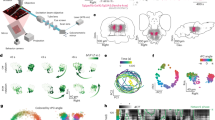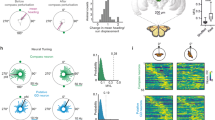Abstract
The cockroachPeriplaneta americana responds to wind puffs by turning away, both on the ground and when flying. While on the ground, the ventral giant interneurons (ventrals) encode the wind direction and specify turn direction, whereas while flying the dorsal giant interneurons (dorsals) appear to do so. We report here on responses of these cells to controlled wind stimuli of different directions. Using improved methods of wind stimulation and of positioning the animal revealed important principles of organization not previously observed.
All six cells of largest axonal diameter on each side respond preferentially to ipsilateral winds. One of these cells, previously thought to respond non-directionally (giant interneuron 2), was found to have a restricted directional response (Fig. 3). The organization of directional coding among the ventral giant interneurons is nearly identical to that among the dorsals (Fig. 2). Each group contains, on each side, one cell that responds primarily to wind from the ipsilateral front, another primarily in the ipsilateral rear, and a third responding more broadly to ipsilateral front and rear.
These results are discussed in terms of the mechanisms of directional localization by the assembly of giant interneurons.
Similar content being viewed by others
Abbreviations
- GI :
-
giant interneuron
- vGI :
-
ventral giant interneuron
- dGI :
-
dorsal giant interneuron
- CF :
-
5-carboxyfluorescein
- A6 :
-
6th abdominal ganglion
- TI:
-
thoracic interneuron
- BED :
-
best excitatory direction
References
Beer RD, Chiel HJ (1993) Simulations of cockroach locomotion and escape. In: Beer RD, Ritzmann RE, McKenna T (eds) Biological neural networks in invertebrate neuroethology and robotics. Academic Press, New York, pp 267–295
Blagburn JM, Beadle DJ, Sattelle DB (1984) Synapses between an identified giant interneurone and a filiform hair sensory neurone in the terminal ganglion of first instar cockroaches,Periplaneta americana. J Exp Biol 113: 477–484
Camhi JM (1985) Feedback control of an escape behavior. In: Barnes WJP, Gladden MH (eds) Feedback and motor control in invertebrates and vertebrates. Croom Helm, London, pp 93–111
Camhi JM (1993) Neural mechanisms of behavior. Current Opinion in Neurobiol 3: 1011–1019
Camhi JM, Levy A (1988) Organization of a complex movement: Fixed and variable components of the cockroach escape behavior. J Comp Physiol A 163: 317–328
Camhi JM, Levy A (1989) The code for stimulus direction in a cell assembly in the cockroach. J Comp Physiol A 165: 83–97
Camhi JM, Nolen TG (1981) Properties of the escape system of cockroaches during walking. J Comp Physiol A 142: 339–346
Camhi JM, Tom W (1978) The escape system of the cockroachPeriplaneta americana: I. The turning response to wind puffs. J Comp Physiol 128: 193–201
Camhi JM, Tom W, Volman S (1978) The escape behavior of the cockroachPeriplaneta americana: II. Detection of natural pred ators by air displacement. J Comp Physiol 128: 203–212
Comer CM (1985) Analyzing cockroach escape behavior with lesions of individual giant interneurons. Brain Res 335: 342–346
Comer CM, Camhi JM (1984) Behavioral compensation for altered cercal position in the cockroach. J Comp Physiol A 155: 31–38
Comer CM, Down JP (1993) Multisensory processing for movement: Antennal and cereal mediation of escape turning in the cockroach. In: Beer RD, Ritzmann RE, McKenna T (eds) Biological neural networks in invertebrate neuroethology and robotics. Academic Press, New York, pp 89–112
Comer CM, Dowd JP, Stubblefield GT (1988) Escape response following elimination of the giant interneuron pathway in the cockroach,Periplaneta americana. Brain Res 445: 370–375
Dagan D, Camhi JM (1979) Responses to wind recorded from the cereal nerve of the cockroachPeriplaneta americana: II. Directional selectivity of the sensory nerves innervating single columns of filiform hairs. J Comp Physiol A 133: 103–110
Daley D (1982) Neural basis of wind-receptive fields of cockroach giant interneurons. Brain Res 238: 211–216
Daley DL, Camhi JM (1988) Connectivity pattern of the cercal-togiant interneuron system of the American cockroach. J Neurophysiol 60: 1350–1368
Daley DL, Vardi N, Appignani B, Camhi JM (1981) Morphology of the giant interneurons and cereal nerve projections of the American cockroach. J Comp Neurol 196: 41–52
Dowd JP, Comer C (1988) The neural basis of orienting behavior: A computational approach to the escape turn of the cockroach. Biol Cybern 60: 37–48
Fuzessery ZM, Buttenhoff P, Andrews B, Kennedy JM (1993) Passive sound localization of prey by the pallid bat (Antrozous pallidus). J Comp Physiol A 171: 767–777
Ganihar D, Libersat F, Wendler G, Camhi JM (1994) Wind-evoked evasive responses in flying cockroaches. J Comp Physiol A 175: 49–65
Georgopoulos AP, Taira M, Lukashin A (1993) Cognitive neurophysiology of the motor cortex. Science 260: 42–52
Glimcher PW, Sparks DL (1992) Movement selection in advance of action in the superior colliculus. Nature 355: 142–145
Goldstein RS, Camhi JM (1991) Different effects of the biogenic amines dopamine, serotonin and octopamine on the thoracic and abdominal portions of the escape circuit in the cockroach. J Comp Physiol A 168: 103–112
Hamon A, Guillet JC, Callec JJ (1994) Patterns of monosynaptic input to the giant interneurons 1–3 in the cereal system of the adult cockroach. J Comp Physiol A 174: 91–102
Heetderks WJ, Batruni R (1982) Multivariate statistical analysis of the response of the cockroach giant interneuron system to wind puffs. Biol Cybern 43: 1–11
Keegan AP, Comer CM (1993) The wind-elicited escape response of cockroaches (Periplaneta americana) is influenced by lesions rostral to the escape circuit. Brain Res 620: 310–316
Levi R, Camhi JM (1994) Testing for a population vector code for wind direction in the cockroach giant interneurons. Soc Neurosci Abstr 20: 418–419
Liebenthal E, Uhlmann O, Camhi JM (1994) Critical parameters of the spike trains in a cell assembly: Coding of turn direction by the giant interneurons of the cockroach. J Comp Physiol A 174: 281–296
Libersat F (1992) Modulation of flight by giant interneurons of the cockroach. J Comp Physiol A 170: 379–392
Libersat F (1994a) The dorsal giant interneurons mediate evasive behavior in flying cockroaches. J Exp Biol 197: 405–411
Libersat F (1994b) Physiological properties of an identified giant interneuron (GI4) as related to the escape and flight circuitries of the cockroachPeriplaneta americana. J Insect Physiol 40: 31–38
Libersat F, Levy A, Camhi JM (1989) Multiple feedback loop in the flying cockroach: Excitation of the dorsal and inhibition of the ventral giant interneurons. J Comp Physiol A 165: 651–668
Masino T, Knudsen EI (1993) Orienting head movements resulting from electrical microstimulation of the brainstem tegmentum in the barn owl. J Neurosci 13: 351–370
Matsumoto SG, Murphey TK (1977) The cercus to giant interneuron system of crickets. IV. Patterns of connectivity between receptors and the medial giant interneuron. J Comp Physiol 119: 319–330
Miller JP, Jacobs GA, Theunissen FE (1991) Representation of sensory information in cricket ceral sensory systems I. Response properties of the primary interneurons. J Neurophysiol 66: 1680–1689
Nicklaus R (1965) Die Erregung einzelner Fadenhaare vonPeriplaneta americana in Abhängigkeit von der Grösse und Richtung der Auslenkung. Z Vergl Physiol 50: 331–362
Ritzmann RE (1981) Motor responses to paired stimulation of giant interneurons in the cockroachPeriplaneta americana: II. The ventral giant interneurons. J Comp Physiol 143: 71–80
Ritzmann RE (1993) The neural organization of cockroach escape and its role in context-dependent orientation. In: Beer RD, Ritzmann RE, McKenna T (eds) Biological neural networks in invertebrate neuroethology and robotics. Academic Press, New York, pp 113–137
Ritzmann RE, Camhi JM (1978) Excitation of leg motor neurons by gaint interneurons in the cockroachPeriplaneta americana. J Comp Physiol 125: 305–316
Ritzmann RE, Pollack AJ (1986) Identification of thoracic interneurons that mediate giant interneuron-to-motor pathways in the cockroach. J Comp Physiol A 159: 639–654
Ritzmann RE, Pollack AJ (1988) Wind-activated thoracic interneurons of the cockroach: II. Patterns of connection from ventral giant interneurons. J Neurobiol 19: 589–564
Ritzmann RE, Pollack AJ (1990) Parallel motor pathways from thoracic interneurons of the ventral giant interneuron system of the cockroach,Periplaneta americana. J Neurobiol 21: 1219–1235
Ritzmann RE, Pollack AJ, Tobias ML (1982) Flight activity mediated by intracellular stimulation of dorsal giant interneurons of the cockroach,Periplaneta americana. J Comp Physiol 147: 313–322
Roeder KD (1963) Nerve cells and insect behavior. Harvard University Press, Cambridge, MA
Roth LM, Willis ER (1960) The biotic associations of cockroaches. Smithsonian Misc Collections, Vol 141, Publ 4422
Salzman CD, Britten KH, Newsome WT (1990) Cortial microstimulation influences perceptual judgements of motion direction. Nature 346: 174–177
Stierle IE, Getman M, Comer CM (1994) Multisensory control of escape in the cockroachPeriplaneta americana. I. Initial evidence from patterns of wind-evoked behavior. J Comp Physiol A 174: 1–11
Tauber E, Camhi JM (1995) The wind-evokod escape behavior of the cricketGryllus bimaculatus: Integration of behavioral elements J Exp Biol [in Press]
Theunissen FE, Miller JP (1991) Representations of sensory information in the cricket cereal sensory system II. Information theoretic calculation of system accuracy and optimal tuningcurve widths of four primary interneurons. J Neurophysiol 66: 1690–1723
Vardi N (1981) Functional recovery from lesions in the escape system of the cockroach. PhD thesis, Cornell University, Ithaca, NY
Westin J (1979) Responses to wind recorded from the cereal nerve of the cockroach,Periplaneta americana. I. Response properties of single sensory neurons. J Comp Physiol 133: 97–102
Westin J, Ritzmann RE (1982) The effect of single giant interneuron lesions on wind evoked motor responses in the cockroachPeriplaneta americana. J Neurobiol 13: 127–139
Westin J, Langberg JJ, Camhi JM (1977) Responses of the giant interneurons of the cockroachPeriplaneta americana to wind puffs of different directions and velocities. J Comp Physiol 121: 307–324
Wine JJ, Krasne FB (1992) The cellular organization of crayfish escape behavior. In: Sandeman DC, Atwood HL (eds) The Biology of Crustacea vol 4, Neural integration and behavior. Academic Press, New York, pp 242–292
Zar JH (1974) Biostatistical analysis. Prentice Hall, Inc. Englewood Cliffs, NJ
Author information
Authors and Affiliations
Rights and permissions
About this article
Cite this article
Kolton, L., Camhi, J.M. Cartesian representation of stimulus direction: Parallel processing by two sets of giant interneurons in the cockroach. J Comp Physiol A 176, 691–702 (1995). https://doi.org/10.1007/BF01021589
Accepted:
Issue Date:
DOI: https://doi.org/10.1007/BF01021589




